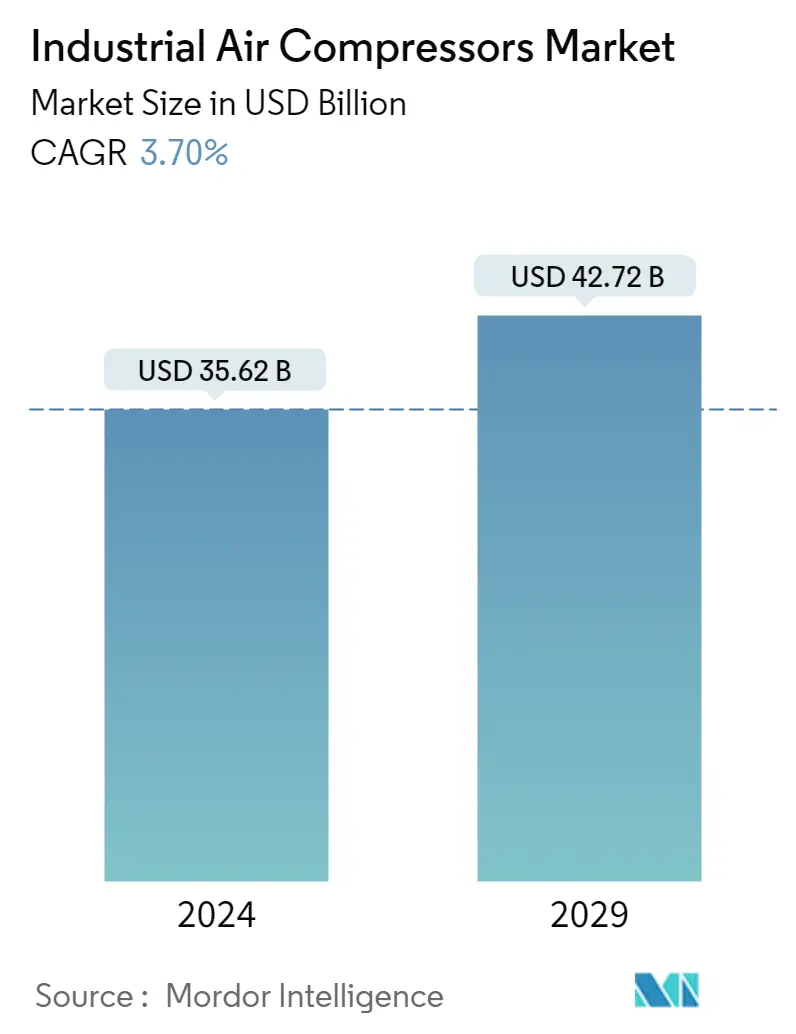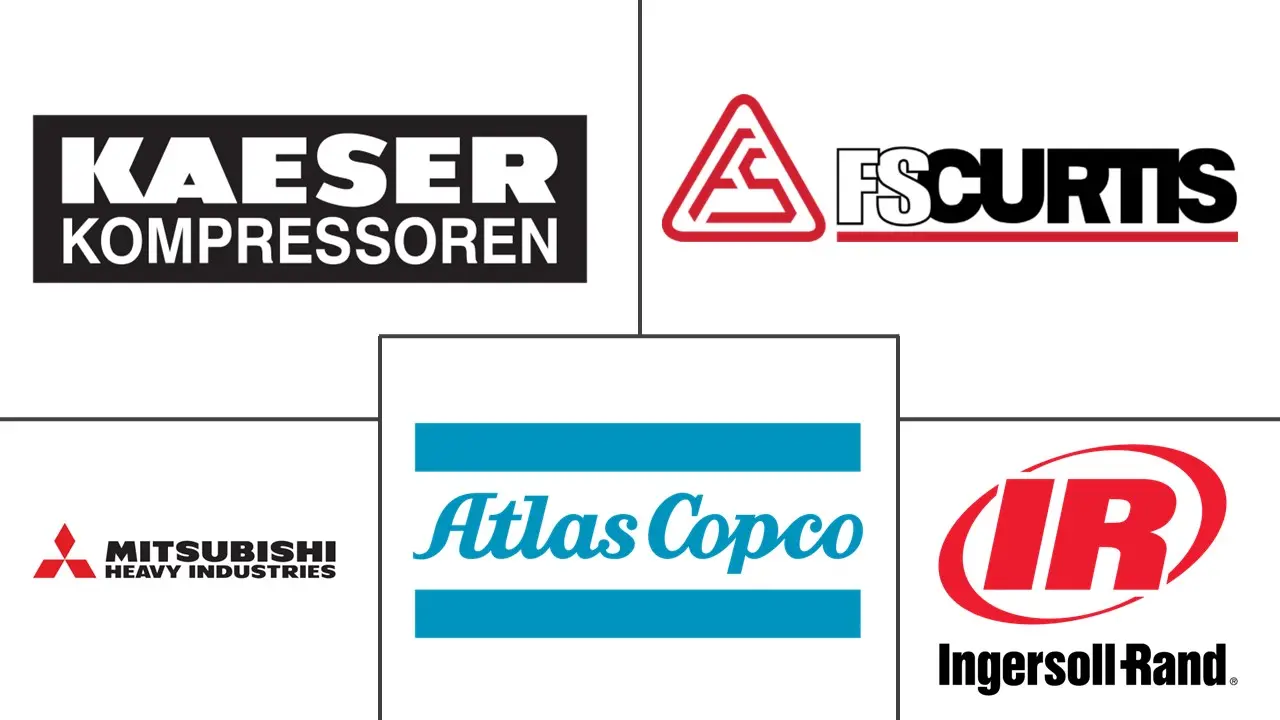Market Size of Industrial Air Compressors Industry

| Study Period | 2019 - 2029 |
| Market Size (2024) | USD 35.62 Billion |
| Market Size (2029) | USD 42.72 Billion |
| CAGR (2024 - 2029) | 3.70 % |
| Fastest Growing Market | Asia Pacific |
| Largest Market | Asia Pacific |
Major Players
*Disclaimer: Major Players sorted in no particular order |
Industrial Air Compressor Market Analysis
The Industrial Air Compressors Market size is estimated at USD 35.62 billion in 2024, and is expected to reach USD 42.72 billion by 2029, growing at a CAGR of 3.70% during the forecast period (2024-2029).
Increases in the oil and gas, petrochemical, transportation, agricultural, and automotive industries globally, as well as increased government support for developing industrial compressor technology, are some important reasons that significantly speed up market expansion.
- A wide range of businesses worldwide generally uses air compressors to deliver compressed air to power complex industrial processes. Heavy-duty industrial air compressors are developed to provide higher pressure levels, as they rely on high horsepower motors and heavy-duty components. In agricultural facilities, these are used to spray crops and ventilate silos, power pneumatic machinery in the manufacturing industries, and oil and gas operations, among others.
- Air compressors have an advantage over electric power and hydraulic power due to their capability to offer flexibility, safety, and low-maintenance cost. Air compressors require fewer moving parts than electrical and hydraulic power systems. However, air compressors need special treatment for the supplied air, as any contamination in the air can damage the supply pipes, leading to corrosion in leakages, ultimately resulting in power output.
- The companies in the market are also continuously investing in developing energy-efficient air compressors. For instance, Atlas Copco mentioned that it is focusing on developing oil-injected technology for offering energy-saving compressor solutions by integrating intelligent control and monitoring systems.
- Moreover, these compressors are used based on the application and location of the compressor to be installed. For instance, reciprocating-type compressors must be installed with flywheels on the side of the wall and an enclosed belt guard, and they need spaces on the sides for maintenance. In the case of the rotary type, the compressors need to be installed so that their inlet grids and ventilation fan may not recirculate the cooling air to the compressor.
- These air compressors used in industries require special cooling units to dispense the heat generated, adding to the companies' initial setup cost. Hence, the companies are looking forward to better-performance compressors to cut down on energy and maintenance costs.
- Apart from these applications, air compressors are also used for petroleum refining, petrochemical synthesis, pipeline transportation, and gas injection. The increasing expansion of oil and gas exploration and investment in the industry are the major factors driving the market growth.
- According to Ingersoll Rand, only 10% to 20% of the energy input to the compressed air systems reaches the point of use, whereas the rest of the energy gets wasted in heat or leaks. This may account for millions of dollars for organizations having large operations.
- Air compressor installation and maintenance costs are very high. Due to the upkeep of intricate monitoring and control systems for various air compressors, the price keeps increasing. This is anticipated to slow market expansion in the near future.
- However, due to the outbreak of COVID-19, Chinese vendors closed their factories, temporarily suspending production facilities. Since the number of COVID-19 cases has reduced in China, the vendors having manufacturing plants based in the region have increased component prices by nearly 2-3%, owing to a shortage of supplies due to factory shutdown. Therefore, this has impacted the entire supply chain from China. The COVID-19 spread has also driven innovations in the compressors segment, with vendors ramping up their production to meet the sudden demand increase.
Industrial Air Compressor Industry Segmentation
An industrial air compressor is a device that uses an electric motor to convert power into potential energy in compressed air form, which is then forced to the storage tanks by these compressors. Depending upon the desired pressure, these can be done in a single-stage or multiple stages. The compressed air is then used in various industries by utilizing the kinetic energy of the air when released.
The Industrial Air Compressors Market is segmented by Type (Rotary Air Compressors, Reciprocating Air Compressors, and Centrifugal Air Compressors), End-user Industry (Oil & Gas, Food & Beverages, Manufacturing, Healthcare, Power Generation, Construction & Mining), and Geography (North America, Europe, Asia Pacific, Latin America, MEA). The market sizes and forecasts are provided in terms of value (USD million) for all the above segments.
| By Type | |
| Rotary Air Compressors | |
| Reciprocating Air Compressors | |
| Centrifugal Air Compressors |
| By End-user | |
| Oil and Gas | |
| Food and Beverages | |
| Manufacturing | |
| Healthcare | |
| Power Generation | |
| Construction and Mining | |
| Other End-user Industries |
| By Geography | |||||||
| |||||||
| |||||||
| |||||||
| Latin America | |||||||
| Middle East and Africa |
Industrial Air Compressors Market Size Summary
The industrial air compressor market is poised for steady growth, driven by increasing demand across various sectors such as oil and gas, petrochemicals, transportation, agriculture, and automotive industries. The market's expansion is further supported by government initiatives aimed at advancing industrial compressor technology. Air compressors are integral to numerous industrial processes, offering advantages over electric and hydraulic power systems, including flexibility, safety, and lower maintenance costs. However, the need for special air treatment to prevent contamination and corrosion poses challenges. Companies are investing in energy-efficient solutions, such as oil-injected technology and intelligent control systems, to enhance performance and reduce operational costs. Despite high installation and maintenance expenses, the market continues to evolve, with innovations spurred by disruptions like the COVID-19 pandemic, which temporarily affected supply chains and production capacities.
China is expected to dominate the industrial air compressor market in the Asia-Pacific region, driven by its robust manufacturing base and supportive government policies. The country's rapid industrialization and urbanization, coupled with stringent energy conservation standards, are key factors propelling market growth. India is also emerging as a significant player, with major manufacturing expansions and increased energy demand contributing to the adoption of industrial air compressors. The market is characterized by intense competition, with major players like Atlas Copco, Ingersoll Rand, and Mitsubishi Heavy Industries striving to maintain their market positions through innovations and strategic acquisitions. Recent developments include the introduction of new compressor models and investments in expanding production capacities, underscoring the industry's focus on meeting diverse industrial needs and enhancing energy efficiency.
Industrial Air Compressors Market Size - Table of Contents
-
1. MARKET INSIGHTS
-
1.1 Market Overview
-
1.2 Industry Value Chain Analysis
-
1.3 Industry Attractiveness - Porter Five Forces
-
1.3.1 Bargaining Power of Suppliers
-
1.3.2 Bargaining Power of Consumers
-
1.3.3 Threat of New Entrants
-
1.3.4 Intensity of Competitive Rivalry
-
1.3.5 Threat of Substitutes
-
-
1.4 Impact of COVID-19 on the market
-
-
2. MARKET SEGMENTATION
-
2.1 By Type
-
2.1.1 Rotary Air Compressors
-
2.1.2 Reciprocating Air Compressors
-
2.1.3 Centrifugal Air Compressors
-
-
2.2 By End-user
-
2.2.1 Oil and Gas
-
2.2.2 Food and Beverages
-
2.2.3 Manufacturing
-
2.2.4 Healthcare
-
2.2.5 Power Generation
-
2.2.6 Construction and Mining
-
2.2.7 Other End-user Industries
-
-
2.3 By Geography
-
2.3.1 North America
-
2.3.1.1 United States
-
2.3.1.2 Canada
-
-
2.3.2 Europe
-
2.3.2.1 United Kingdom
-
2.3.2.2 Germany
-
2.3.2.3 France
-
2.3.2.4 Rest of Europe
-
-
2.3.3 Asia- Pacific
-
2.3.3.1 China
-
2.3.3.2 Japan
-
2.3.3.3 India
-
2.3.3.4 South Korea
-
2.3.3.5 Rest of Asia-Pacific
-
-
2.3.4 Latin America
-
2.3.5 Middle East and Africa
-
-
Industrial Air Compressors Market Size FAQs
How big is the Industrial Air Compressors Market?
The Industrial Air Compressors Market size is expected to reach USD 35.62 billion in 2024 and grow at a CAGR of 3.70% to reach USD 42.72 billion by 2029.
What is the current Industrial Air Compressors Market size?
In 2024, the Industrial Air Compressors Market size is expected to reach USD 35.62 billion.

